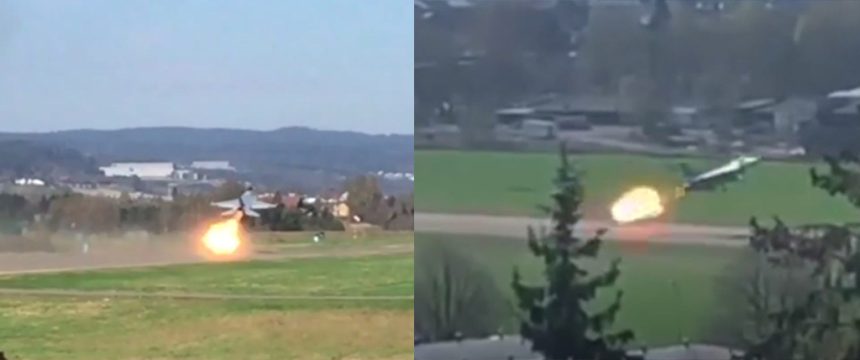Caught on video: an RNoAF F-16 ingests a bird during take off.
Birds ingested in aircraft engines can have devastating effects. The video below, shared on Twitter by Stephen Trimble, Aviation reporter and editor for Flightglobal’s Americas bureau (@FG_STrim), was reportedly filmed on May 7 at Kjeller airport. It shows a Royal Norwegian Air Force F-16 taking off for a test flight following maintenance activity.
At 00:19 you can clearly see the aircraft’s engine emanating flames (generating a loud bang) in what seems to be the typical behaviour of a compressor stall. Without retracting the landing gear, the F-16 continues to climb to perform an emergency landing a few minutes later at Oslo Gardemoen.
We have often commented videos of photographs of jets suffering compressor stalls. Here’s the explanation we published last time:
Compressor stalls (sometimes referred to as afterburner stalls in aircraft with reheat) are not too rare among military aircraft. They can be caused by several factors, including birdstrikes, FOD (Foreign Object Damage), ingestion of turbulent or hot airflow into the air intake etc.
A compressor stall is a local disruption of the airflow in the compressor whose severity may vary from a momentary power drop to a complete loss of compression.
A particular kind of compressor stall is the compression surge that occurs when the hot vapour generated by the aircraft carrier’s catapult is ingested by the aircraft air intake thus creating a breakdown in compression resulting in a the compressor’s inability to absorb the momentary disturbance and to continue pushing the air against the already-compressed air behind it. As a consequence, there’s a momentary reversal of air flow and a violent expulsion of previously compressed air out through the engine intake producing some loud bangs from the engine and “back fires”.
You can find several images of aircraft suffering compressor surges while taking off from airbases or being launched from the flight deck of an aircraft carrier.
As already explained on The Aviationist in the past, in most of the cases even after suffering a “surge” the compressor will usually recover to normal flow once the engine pressure ratio reduces to a level at which the compressor is capable of sustaining stable airflow.
Some engines have automatic recover functions even if pilots experiencing the surge can be compelled to act on the throttle or, in some cases, relight the engine.
According to the reports issued later by the RoNAF, the aircraft suffered a “birdstrike”: the bird(s) got sucked into the F-16’s air intake causing the compressor stall and the consequent distinct long flame.
Here’s the May 7 incident, filmed from distance at two different locations:
H/T @FG_STrim for the heads-up.
Update Jun. 19, 2018:
We have received an email from Pierric Joseph, an associated professor in a engineer school) that provides more accurate explanation of what a compressor surge is. Here’s an excerpt from PJ’s message:
“You state that compressor surge is a particular case when engine ingests hot vapour generated by launch catapult, this is not totally true.
The general phenomenon is compressor stall. It can be divided into two categories:
– Compressor surge : all the rotor blade blades “lose” (i.e. the airfoil stalls like an airplane wing) the airflow at the same time, then get it again, then lose it again, etc. Due to this particular motion, we call it “pumping” in my language.
– Rotating stall : only a few blades on the annulus “lose” the airflow, and you get some kind of stalled pockets (you can have several of them) which rotates with a different velocity than the rotor (and in the opposite direction).
Usually, you go to rotating stall then to full stall (or surge). So the actual challenge is to detect early warning of the rotating stall and to take the appropriate measures.
Another cause of compressor stall, if you want to be more exhaustive: you can add smoke ingestion due to missile shot (some particular engines go to special mode when firing missile – not a secret thing, it is even written on some wikipedia page for some particular engine).”









